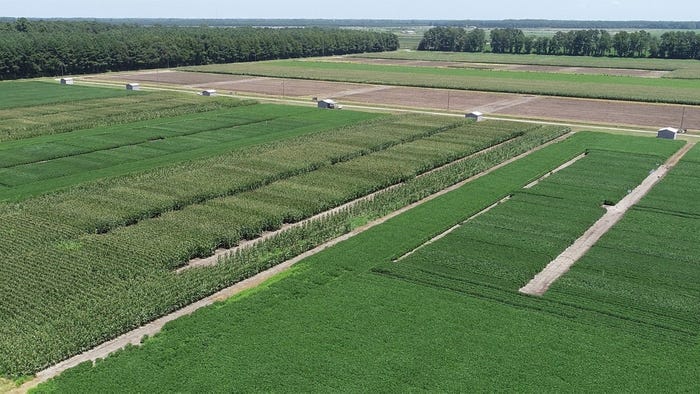
At a Glance
- The system removes or adds water through the infrastructure, while monitoring water and nutrient inputs and outputs.
- Overall, they average about 216 bushels per acre across 20 hybrids with much higher nitrogen fertilizer use efficiency.
Corn farmers looking to push their yields to higher levels can receive dividends in both higher yields and fertilizer-use efficiency with drainage and irrigation on their farms to handle the challenges of water stress.
Since 2021, Chad Poole, North Carolina State University Extension water resiliency specialist, and his team has used drainage and irrigation infrastructure to evaluate genetics and soil water stress at the Tidewater Research Station in Plymouth, NC.
Water stress, either in excess or lacking, impacts yield, so water stress management is critical for maximizing yields and profits.

At the Total Ag Water Management site at the Tidewater station, water can be either added or taken away to simulate drought or excess water conditions. (Photo courtesy of Chad Poole)
Simulating water conditions
In the Total Ag Water Management site at the Tidewater research station, water can be either added or taken away to simulate drought or excess water conditions. It’s an engineering marvel, with state-of-the-art tools like sensors to monitor water table and soil water conditions in the field.
The system determines whether to remove or add water through the infrastructure, while simultaneously monitoring water and nutrient inputs and outputs from the system.
Poole emphasized that water stress clearly impacts nutrient uptake in a corn plant, and for corn to maximize nutrient uptake, water stress must be eliminated.
Poole notes that the intensive drainage system really paid off in achieving optimal yields in 2021, a wet year. In 2021, researchers examined 14 hybrids at the Tidewater station.
With a less intensive drainage system, yields were 160 bushels per acre, but with the intensive drainage system, yields were 180 bushels per acre. By h2aving no drainage at all, yields were only 108 bushels per acre.
“In 2021, when we had a lot of rainfall and a lot of drainage water leaving the field, the intensive drainage system was 74% efficient in nitrogen utilization among hybrids. By having poor drainage, we were only 49% efficient. The cost of nitrogen in 2021 was well over $1 per pound. We were putting 200 pounds per acre on these plots so the total loss of nitrogen that was not used by the corn crop, by having poor drainage, was over 100 pounds per acre,” Poole explained in a video presentation at a corn meeting at the Bertie County Extension Center in Windsor, on February 19.
“By improving the drainage system and making sure we weren’t waterlogged, the plants could use that nitrogen. We increased the nitrogen use efficiency to 75% of what was applied, so the total loss under intensive drainage was only 48 pounds compared to the 100 pounds lost under poor drainage in that year. That is a 25% increase in nitrogen use efficiency.”
2022 was an average weather year. During a drought at the end of the growing season, researchers used both drainage and irrigation throughout the season in the optimal water management system. That year, they saw a yield increase of 40 bushels per acre compared to over drained and wet conditions across all hybrids.
“Overall, we were averaging about 216 bushels per acre across the 20 hybrids with much higher nitrogen fertilizer use efficiency where we had the ability to manage stress through the infrastructure of drainage or irrigation at the site,” Poole said.
Goal: Complete nitrogen-use efficiency
Poole said the objective for farmers is to achieve 100% nitrogen-use efficiency. “If we are going to apply 200 units of nitrogen per acre to this crop, we want to make sure we put 200 pounds per acre back into that crop. We want that crop to utilize it. Either it needs to go into the grain which is the best-case scenario because we maximize yields, or it needs to go into the biomass or foliage. This way we still have a chance to get a return on the nitrogen fertilizer with the next crop.”
Essentially, water stress — either too much or not enough — puts corn in a low-yielding environment and reduces nitrogen-use efficiency.
“If we don’t have the ability to react to climate conditions that are imposed in the field whether that’s too much water or not enough water, the return on fertilizer investment is going to be low and so are the yields,” Poole said. “As we make improvements to both drainage and irrigation systems, we ensure that we will be in a high yielding environment that protects year-to-year profits. Not only will we maximize grain yields, we also are going to maximize the return on investment in fertilizers. The dollar a pound that we were paying out for nitrogen is utilized by the plant in either the grain or the biomass.”
Additionally, genetic selection and placement based on a soil’s ability to hold water can be a major tool for producers to mitigate climate-induced stress in cases where irrigation and drainage infrastructure is not ideal.
“Knowing which genetics can yield in wet environments versus dry environments can increase per acre returns in excess of $200 to $400 per acre before the seed is even planted,” Poole said.
The water stress trials, sponsored by the Corn Growers Association of North Carolina and supported by industry partners, help to provide this information to producers across North Carolina through the cooperative extension system.
Read more about:
ClimateAbout the Author(s)
You May Also Like






